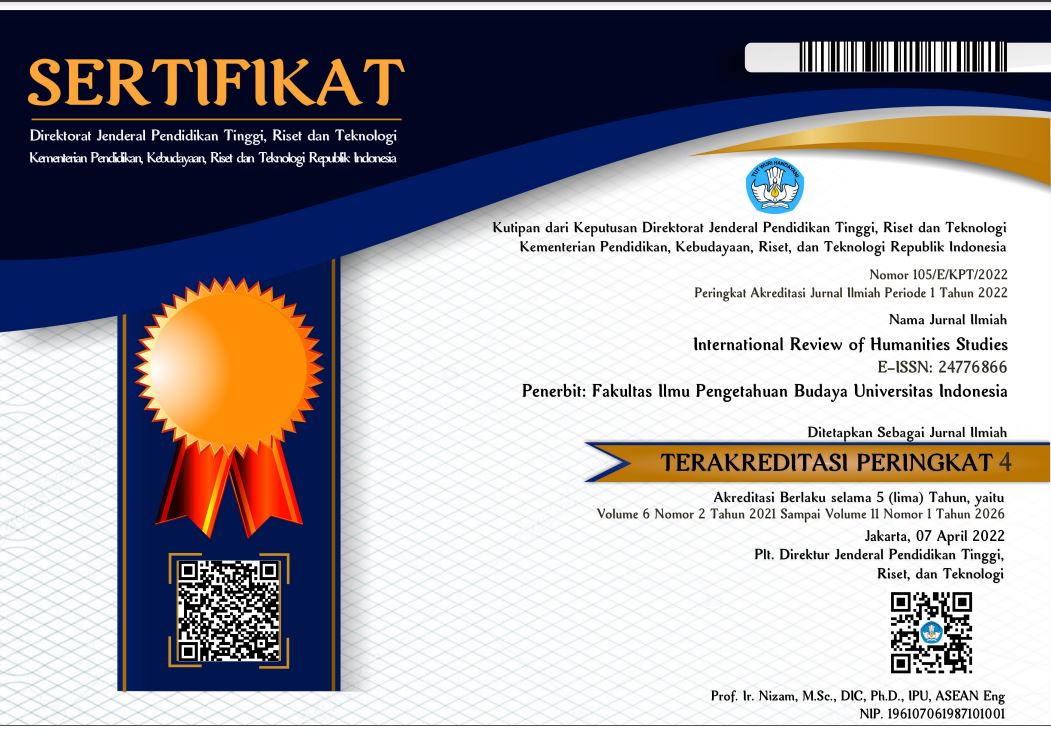International Review of Humanities Studies

Abstract
In Indonesia Multatuli's Max Havelaar is regarded as a powerful indictment of Dutch colonialism in Indonesia. Extensive research has explored the novel's historical context, social critique, and its influence on Indonesian nationalism, but less attention has been paid to the literary devices that give the novel its enduring emotional power. This paper fills this gap by examining how metaphor and simile presented in the dialogs found in the novel function as key instruments in shaping the reader's experience. Existing studies of Max Havelaar often delve into the novel's historical background, its scathing critique of Dutch colonial practices, and its role in igniting Indonesian nationalist sentiment. However, such analyses often underemphasize the specific literary devices employed by Multatuli and how they contribute to the novel's lasting impact. This paper offers a fresh perspective by delving into the novel's emotional core and demonstrating how metaphor and simile are not mere decorative elements but strategically employed tools. By analyzing the emotional impact of these figures of speech, this essay contributes to a deeper understanding of Max Havelaar's enduring power as a critique of colonialism and a testament to the human cost of oppression. This paper concludes that metaphors and similes create a profound connection between the reader and the suffering of the Javanese people. These figures of speech expose the brutality and hypocrisy inherent in Dutch colonialism, while simultaneously universalizing the human experience of oppression and fostering cross-cultural empathy. Ultimately, this analysis demonstrates how Max Havelaar's effectiveness as a critique hinges on its ability to forge strong emotional bonds with readers.
References
Books:
- Boef, J. van. (2004). The dynamics of metaphor in Indonesian poetry: A cognitive stylistic approach. Amsterdam: John Benjamins Publishing Company.
- Damarjati, E. (2015). Simile dalam prosa Ahmad Tohari: Kajian stilistika kognitif. Jurnal Bahasa, 19(2), 233-244.
- Foulcher, P. M. (2013). Resistance and rebellion in Southeast Asia: Colonialism, emancipatory struggles, and legacies. Routledge.
- Kumar, R. (1999). Sejarah Indonesia. (Terjemahan). Gramedia Pustaka Utama.
- Lakoff, G. (1987). Women, fire, and dangerous things: What categories reveal about the human mind. Chicago: University of Chicago Press.
- Lakoff, G., & Johnson, M. (1980). Metaphors we live by. Chicago: University of Chicago Press.
- Lakoff, G., & Turner, M. (1989). More about metaphors. Cambridge: Cambridge University Press.
- McKay, J. (1995). Tramways and trops: Colonial architecture and the shaping of Indonesian cities. Oxford University Press.
- Ricklefs, M. C. (1993). Gajah mati di pelarian: Indonesian literature and history in the 1930s. Leiden: KITLV Press.
- Teeuw, A. (1989). Sastra Indonesia mutakhir: Sebuah pengantar. Pustaka Utama.
- Shiraishi, T. (1990). Colonial education: A reinterpretation. Routledge.
Articles:
- Millstein, J. H. (2019). Renewing empathy with imagery and metaphor. Journal of Applied Communication Research, 48(3), 237-258. https://doi.org/10.1177/2374373519846656
- Millstein, Jeffrey H. "Renewing Empathy With Imagery and Metaphor." Journal of Applied Communication Research 48.3 (2019): 237-258. https://www.researchgate.net/publication/378075568_An_integrative_analysis_of_potential_mechanisms_of_reduced_positive_affect_in_daily_life_in_depression_an_ESM_study
- Redfearn, J. (2003). An introduction to cognitive linguistics. Cambridge University Press.
Recommended Citation
Lucia Pesulima, Barbara Elisabeth
(2024)
"BUILDING EMPATHY AND UNVEILING REALITY: THE ROLE OF METAPHOR AND SIMILE IN MAX HAVELAAR,"
International Review of Humanities Studies: Vol. 9:
No.
2, Article 8.
DOI: 10.7454/irhs.v9i2.1310
Available at:
https://scholarhub.ui.ac.id/irhs/vol9/iss2/8
Included in
Anthropology Commons, Art and Design Commons, Creative Writing Commons, Cultural Heritage Law Commons, Dutch Studies Commons, Education Law Commons, Film and Media Studies Commons, History Commons, Intellectual Property Law Commons, International and Area Studies Commons, Legal Writing and Research Commons, Linguistics Commons, Museum Studies Commons, Philosophy Commons, Urban Studies and Planning Commons


